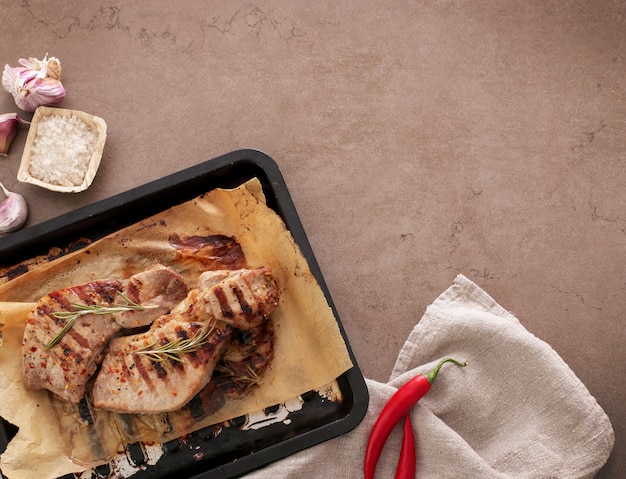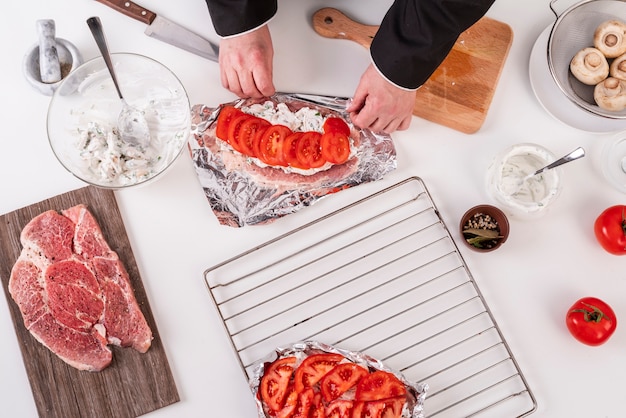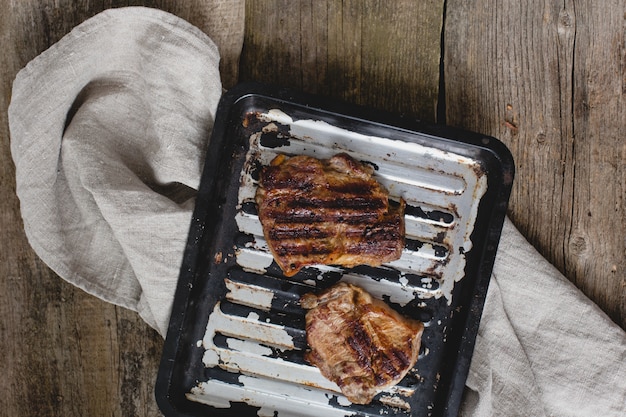Let's be honest, folks, pork can be a bit of a culinary enigma. Cook it wrong, and you're left with a dry, tough mess. But get it right, and oh boy, it's a flavour explosion! As a seasoned cook, I've had my fair share of pork mishaps. Those dry, overcooked roasts… I still cringe thinking about them! But through trial, error, and a whole lot of delicious experimentation, I've finally cracked the code.
This guide is more than just a list of cooking times – it's your roadmap to achieving pork perfection. We'll dissect different cuts, explore various cooking methods, and unveil the secrets to juicy, tender results. We'll even debunk some common pork myths and address those burning questions that keep you up at night. So, gather your ingredients, sharpen your knives, and let's dive into the fascinating world of pork!
(Part 1) Understanding pork cuts: A Porky Journey of Discovery

Before we even think about firing up the stove, we need to get familiar with the different cuts of pork. Each cut has its own personality – some are lean and tender, while others are rich and flavorful. choosing the right cut for your dish is the first step to pork paradise!
1.1 The Loin: The Versatile King
Picture the loin as the royal family of pork cuts – it's the most versatile and popular. Think of it as a blank canvas for culinary creativity. Whether you're roasting, grilling, or pan-frying, the loin delivers a consistently tender and lean bite.
Within the loin family, you'll find two prominent members: the tenderloin and the sirloin. The tenderloin is the epitome of tenderness – perfect for those who prefer a delicate bite. The sirloin, on the other hand, has a little more fat, giving it a richer, more flavorful experience. It's like the difference between a classic white tee and a luxurious silk shirt – both beautiful, just with a different level of richness.
1.2 The Shoulder: A Slow-Cooker's Dream
Now, let's talk about the shoulder, also known as the Boston butt (a name that's a bit misleading, as it actually refers to the top part of the shoulder). This cut is the ultimate slow-cooker champion, perfect for braising, pulling, and those melt-in-your-mouth dishes.
The shoulder has a good amount of fat, which melts down during long cooking times, creating a luscious, succulent masterpiece. Think of it as a slow-burning candle – it may take a while, but the end result is pure magic!
1.3 The Ribs: A Barbecue Classic
Ah, ribs. These glorious strips of pork are a barbecue staple, perfect for grilling or smoking. The ribs are known for their succulent meat and the delectable, smoky flavor they absorb during long, slow cooking. Imagine the tender meat pulling away from the bone with every bite – pure barbecue bliss!
1.4 The Belly: The Bacon's Cousin
The belly is where the beloved bacon comes from, so you know it's going to be rich and flavorful! This cut is a bit like the pork equivalent of a decadent dessert – it's full of fat and packed with flavor. The belly is best for slow cooking methods like braising or roasting, allowing the fat to render and create a deliciously juicy texture.
Think of pork belly as the ultimate comfort food ingredient. It's the star of dishes like crispy pork belly burnt ends, which are essentially caramelized, smoky, and irresistible bites of heaven!
1.5 The Chops: Versatile and Flavorful
Chops, cut from the loin, are a versatile and popular choice for quick meals. They come in various thicknesses, from thin and tender to thick and juicy. Whether you're grilling, pan-frying, or even baking, pork chops are a reliable and delicious option.
(Part 2) Cooking Methods: Unlocking Pork's Potential

Now that we've explored the pork landscape, let's dive into the different ways we can cook these cuts. Each method unlocks a unique texture and flavor, so choose wisely based on your personal preferences and the cut you're working with.
2.1 Roasting: A Classic for a Reason
Roasting is a time-honored method for large cuts like the loin or shoulder. The slow, steady heat of the oven allows the fat to render slowly, creating a juicy and flavorful result. The key here is to maintain even heat and ensure the pork cooks thoroughly without drying out.
2.2 Grilling: Sizzling Summertime Delight
Grilling is the ultimate summertime cookout method, and it shines with smaller cuts like chops or tenderloin. The intense heat of the grill creates a beautiful sear on the outside while locking in moisture inside. The result? A perfectly charred exterior and a juicy, tender interior – a true grilling masterpiece.
2.3 Pan-Frying: Quick and Easy Weeknight Wonders
Pan-frying is a simple and efficient method for quick weeknight meals. It's perfect for chops or tenderloin, delivering a crisp crust and a succulent interior. The trick here is to sear the meat properly to ensure a lovely golden brown crust.
2.4 Braising: Tenderizing the Tough Stuff
Braising is a slow-cooking method that's perfect for tougher cuts like the shoulder or belly. Imagine a symphony of flavors – the meat is browned in a pan, then simmered in liquid until it becomes incredibly tender. The liquid infuses the meat with delicious aromas and creates a rich sauce that elevates the entire dish. Braising is a true testament to slow-cooking magic!
2.5 Slow Cooking: Patience is a Virtue
Slow cooking is another great way to tame those tougher cuts of pork. This method involves letting the meat simmer in a slow cooker for hours, breaking down the tough fibers and creating a melt-in-your-mouth texture. Think of slow cooking as a culinary lullaby – it takes time, but the results are incredibly rewarding.
2.6 Smoking: The Art of Smoky Flavor
Smoking is the ultimate way to infuse pork with a distinct smoky aroma. This method is popular for ribs and shoulder, where the long, slow cooking process creates a depth of flavor that's truly unparalleled. The smoky aroma and tender texture are a true testament to the magic of slow-cooking.
(Part 3) internal temperature: The Key to Pork Perfection

Here's the golden rule of pork cooking: always check the internal temperature. It's the only way to ensure the meat is cooked through and safe to eat. Pork should reach an internal temperature of 145°F (63°C). This temperature guarantees the elimination of any harmful bacteria while preserving the meat's juicy texture.
Invest in a good meat thermometer – it's a small investment that guarantees your safety and unlocks the potential of delicious pork. Insert the thermometer into the thickest part of the meat, avoiding bones, and let it do its magic. Once it hits 145°F, you're good to go!
3.1 Resting Time: The Unsung Hero
Here's a little secret – resting time is crucial for achieving perfectly juicy pork. After cooking, let the meat rest for 10-15 minutes before carving. This allows the juices to redistribute throughout the meat, resulting in a more tender and flavorful dish. Think of it as a post-workout recovery session for your pork – it helps it relax and regain its full potential!
(Part 4) Pork Cooking Times: A Culinary Guide
Let's get down to the nitty-gritty – those all-important cooking times. Remember, these are just general guidelines, and the actual time will vary depending on the size and thickness of the cut, the cooking method, and your desired level of doneness.
4.1 Roasting: A Guide to Golden Pork
For a pork loin roast, aim for approximately 20-30 minutes per pound at 325°F (163°C). You can check for doneness with your trusty meat thermometer, ensuring it reaches 145°F (63°C). The key here is to maintain even heat and resist the urge to peek too early. Patience is key to a perfectly roasted pork!
4.2 Grilling: Sizzling Perfection
For pork chops, grill over medium heat for about 5-7 minutes per side. For a pork tenderloin, grill over medium heat for about 15-20 minutes, turning every few minutes. The goal here is to achieve a beautiful sear while keeping the inside juicy and tender. Remember to avoid overcooking, as it will result in dry and tough pork.
4.3 Pan-Frying: A Quick and Easy Feast
For pork chops, pan-fry over medium heat for about 4-6 minutes per side. For a pork tenderloin, pan-fry over medium heat for about 10-12 minutes, turning every few minutes. The trick here is to heat the pan properly and ensure a nice sear without overcooking the meat. Pan-frying is all about quick and precise cooking!
4.4 Braising: Tenderness on a Slow Burn
For a pork shoulder, braise in a dutch oven for about 2-3 hours, or until it's fork-tender. For pork belly, braise for about 1-2 hours, or until it's tender and the fat has rendered. Braising is a game of patience, where the slow, gentle heat breaks down the tough fibers and transforms the meat into a culinary delight. Don't be tempted to rush the process, let the magic of braising work its wonders!
4.5 Slow Cooking: The Art of Easy Eating
For a pork shoulder, slow cook on low heat for about 8-10 hours. For pork belly, slow cook on low heat for about 6-8 hours. Slow cooking is all about setting and forgetting, allowing the meat to simmer and become incredibly tender. The result? A perfectly tender and flavorful pork that practically melts in your mouth.
4.6 Smoking: A Smoky Symphony
For pork ribs, smoke at 225°F (107°C) for about 4-6 hours, or until they're tender and the meat pulls back easily from the bone. For a pork shoulder, smoke at 225°F (107°C) for about 10-12 hours, or until it's fork-tender. Smoking is an art form that takes time, patience, and a keen eye. But the results are worth every second, as the meat absorbs the smoky aroma and transforms into a true culinary masterpiece.
(Part 5) Pork Recipe Ideas: Inspiration Awaits
Now that you've got the basics down, let's get those creative juices flowing with some mouthwatering pork recipe ideas. These dishes showcase the versatility of pork and are guaranteed to impress your friends and family.
5.1 Roasted Pork with Apple Cider Glaze: A Sweet and Savory Classic
This dish is a classic for a reason! The apple cider glaze adds a sweet and tangy flavor that complements the succulent pork perfectly. It's a crowd-pleaser that's sure to be a hit at any gathering.
5.2 grilled pork chops with Mango Salsa: A Tropical Treat
These grilled pork chops are bursting with flavor, thanks to the vibrant mango salsa. It's a light and refreshing dish, perfect for a summer barbecue or a light dinner. The combination of sweet and savory flavors is a real treat!
5.3 pan-fried pork tenderloin with Lemon Herb Sauce: Elegance in Simplicity
This pan-fried pork tenderloin is juicy and flavorful, and the lemon herb sauce is the perfect complement. It's a simple yet elegant dish that's perfect for a romantic dinner or a special occasion. The citrusy flavors and fresh herbs elevate the dish to a new level of deliciousness.
5.4 Slow Cooker pulled pork sandwiches: Comfort Food at its Finest
These pulled pork sandwiches are a real comfort food classic. The pork is so tender it practically falls apart, and the tangy barbecue sauce is the perfect topping. It's a simple, satisfying dish that's perfect for a lazy weekend or a casual gathering with friends.
5.5 smoked ribs with bbq sauce: A Barbecue Masterpiece
These smoked ribs are a true barbecue masterpiece! They're fall-off-the-bone tender and have a delicious smoky flavor. The barbecue sauce adds a layer of sweetness and tanginess that perfectly complements the meat. These ribs are a true testament to the art of slow-cooking and are guaranteed to impress even the most discerning barbecue enthusiast.
(Part 6) Pork Storage and Leftovers: Making the Most of Your Pork
It's always a joy to have leftover pork, but how long can you keep it? Here's a quick guide to proper pork storage.
6.1 Refrigerating Cooked Pork: Safe and Delicious
Cooked pork can be stored in the refrigerator for 3-4 days. Be sure to store it in an airtight container or wrap it tightly in plastic wrap or aluminum foil to prevent freezer burn.
6.2 Freezing Cooked Pork: A Delicious Time Capsule
You can also freeze cooked pork for up to 2-3 months. Again, store it in an airtight container or wrap it tightly. When ready to use, thaw the pork in the refrigerator overnight.
6.3 Reheating Cooked Pork: Bringing Back the Flavor
To reheat cooked pork, you can use the oven, stovetop, or microwave. Just ensure the internal temperature reaches 165°F (74°C) to ensure it's safe to eat. You can reheat pork in various ways, such as adding it to soups, stews, or stir-fries, or using it to create delicious sandwiches or wraps.
(Part 7) pork safety: A Culinary Guide to Safe Eating
Let's be honest, food safety is no joke! Here are some important tips to keep in mind when handling and cooking pork.
7.1 Handwashing: The First Line of Defense
Always wash your hands thoroughly with soap and water before and after handling raw pork. This simple step prevents the spread of bacteria and ensures a safe and delicious meal.
7.2 Cross-Contamination: Avoiding Culinary Mishaps
Avoid cross-contamination by using separate cutting boards and utensils for raw pork and other foods. This prevents the transfer of bacteria from raw meat to other ingredients. Remember, clean and separate is the name of the game in safe food handling!
7.3 Thorough Cooking: The Key to Food Safety
As we've discussed, ensure that your pork is cooked to an internal temperature of 145°F (63°C) to kill any harmful bacteria. Using a meat thermometer is the best way to guarantee safe eating. Don't be tempted to skip this step, as it's essential for preventing foodborne illnesses.
7.4 Proper Storage: Keeping Your Pork Fresh
Store raw pork in the refrigerator at 40°F (4°C) or below. Don't leave it out at room temperature for more than two hours. Proper storage helps prevent bacteria from multiplying and ensures your pork stays fresh and safe to eat.
(Part 8) FAQs: Your Pork Questions Answered
Got questions about pork? I've got answers!
8.1 Can I Eat Pork That's Pink in the Middle?
No, you should not eat pork that's pink in the middle. The pink color indicates that the meat is not cooked through, and it could contain harmful bacteria. Always ensure pork is cooked to an internal temperature of 145°F (63°C) to ensure it's safe to eat.
8.2 Is It Okay to Eat Pork That's a Bit Overcooked?
While it's safe to eat pork that's overcooked, it won't be as juicy and flavorful as pork that's cooked to the right temperature. Aim for an internal temperature of 145°F (63°C) to ensure the pork is cooked through but still tender and juicy.
8.3 What's the Difference Between Pork and Ham?
Ham is a cured pork product. It's typically made from the hind leg of the pig and is cured with salt, sugar, and other ingredients. Ham can be cooked whole or sliced and used in various dishes. Ham has a distinct salty flavor due to the curing process, while fresh pork has a more delicate and natural taste.
8.4 What's the Best Way to Tell if Pork is Done?
The best way to tell if pork is done is to use a meat thermometer. Insert the thermometer into the thickest part of the meat, making sure not to touch bone. It should read 145°F (63°C). You can also check for doneness by pressing on the meat; it should feel firm and springy.
8.5 What Are Some Good side dishes to Serve with Pork?
There are endless possibilities when it comes to side dishes for pork. Some classic choices include mashed potatoes, roasted vegetables, cornbread, and coleslaw. These side dishes complement the flavors of pork and create a well-rounded meal. Don't be afraid to experiment and create your own unique combinations!
(Part 9) Conclusion: A Porky Farewell
So, there you have it – a comprehensive guide to perfectly cooked pork, from understanding different cuts to mastering various cooking methods. Now, go forth and cook some delicious pork dishes that will impress your friends and family. Remember to cook to the right internal temperature, let your pork rest, and have fun experimenting with different recipes and techniques.
Happy cooking, and may your pork always be juicy, tender, and delicious!
Everyone is watching

Corn on the Cob: The Ultimate Guide to Perfectly Cooked Ears
Healthy MealsAh, corn on the cob. Just the name evokes images of sunny days, barbecues, and that sweet, juicy flavour that ...

Perfect Pork Roast Oven Cooking Time: A Guide to Delicious Results
Healthy MealsThere's something truly satisfying about a perfectly roasted pork. The aroma alone is enough to make your mout...

Ham Cooking Time: How Long to Bake, Smoke, or Boil a Delicious Ham
Healthy MealsAh, ham. It's a classic, isn't it? A real crowd-pleaser, especially around holidays. And when done right, it'...

Scallops: The Ultimate Guide to Perfect Cooking
Healthy MealsAh, scallops. Those delicate, sweet, and utterly delicious morsels of the sea. They hold a special place in my...

Spaghetti Squash: The Ultimate Guide to Cooking and Serving
Healthy MealsRemember that time you saw spaghetti squash at the supermarket, looking all bumpy and strange, and thought, "W...
